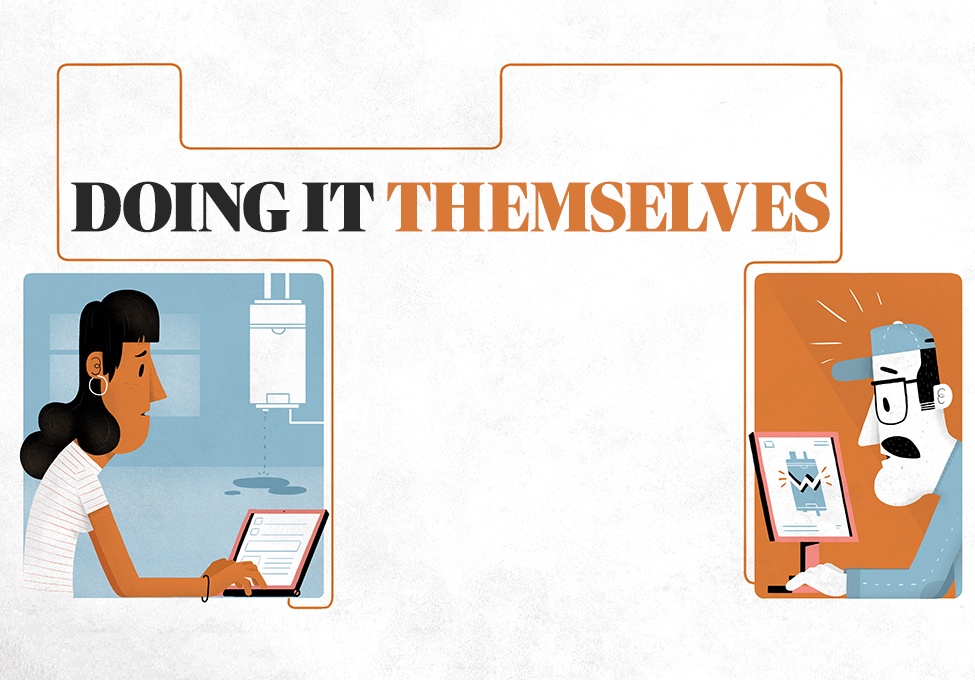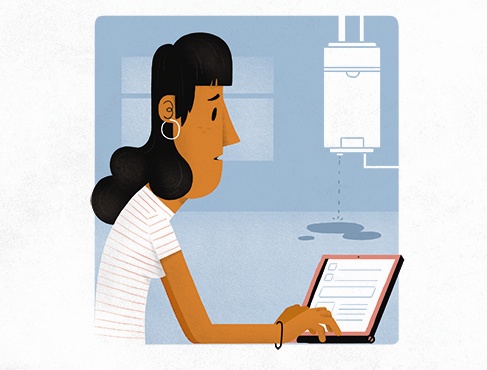You are viewing 1 of your 1 free articles
Doing it themselves
Housing associations are increasingly handing tenants control over the planning and booking of repairs to their homes. Tim Clark investigates the implications
Video:
features style

It has been hailed as the answer to registered providers’ funding concerns in an age of rent cuts and tightened budgets: a system which takes the responsibility for repairs out of the hands of staff and into those of the tenant, empowers tenants, and saves costly labour hours in the process.
Video:
Ad slot
However, with complicated IT processes, liaising with contractors and an overhaul of an in-house work culture essential to making any new self-service system a success, is the self-service model worth pursuing?
Sector-wide solution
Self-service repairs systems allow tenants to take charge of the maintenance of their property and log faults themselves using their landlord’s website.
Systems vary but in essence any repair can be logged through a private portal and an appointment made by the tenant for a repair or an inspection and assessment, if needed. The main difference is that initial contact has been streamlined, with no need for a phone call to fill in details of the issue.
3C Consultants is one of the largest providers of ICT consultancy in the social housing sector. For managing director Colin Sales, the financial challenges housing associations face mean the model is likely to become de rigueur.
“It’s not a case of if, but when housing associations will adopt self-service models.”
Colin Sales, managing director, 3C Consultants
“It’s not a case of if, but when housing associations will adopt self-service models,” he says. “I think within three years everyone will have either done it or be close to doing it.
“The argument is that by introducing this kind of automation you can save a tremendous amount of money. There is also a chance that if you don’t adopt the system you could fall foul of the HCA [Homes and Communities Agency] at some point and may be the target of a merger.
“This is because on a regular basis housing associations have to report their performance to the HCA, and if there is a concern the HCA may investigate them. If the HCA is not happy with what it finds, it can downgrade the association, which can make it a target. Then the pressure on the organisation only increases.”
Repairs and maintenance take up a large slice of any provider’s budget. Inside Housing’s survey of the UK’s 100 largest housing associations revealed expenditure on repairs and maintenance passed £2.5bn for the first time in 2014/15. And as costs have risen, repair times have slackened, with the median time to complete a repair rising to 8.3 days in 2014/15 from a low of 7.3 days at the median in 2011/12.
Not only are repairs costly, they are also among tenants’ main concerns. According to a 2014 survey by the Tenants’ and Residents’ Organisations of England, repairs are a top priority for 40% of respondents – more than any other issue.
However, despite the high value placed on repairs, according to Mr Sales housing associations have not responded well to their tenants’ demands. “The productivity of the repairs area of housing associations is notoriously poor,” he says.
“With many providers you find that when a tenant reports an issue, if it can’t be dealt with straight away the call is passed around departments; it takes up a lot of time. Ideally something should be fixed on the first contact, which is a visit.”
Cost savings are among the most popular reasons for any landlord to implement a self-service system. However Martin Pollhammer, chief executive of East Lothian Housing Association (ELHA), warns any provider looking to put self-service into practice simply as a cost-saving measure will fall short.
“The productivity of the repairs area of housing associations is notoriously poor.”
Colin Sales, managing director, 3C Consultants
“Savings is the first question everybody in the sector asks and is the one I won’t really answer,” Mr Pollhammer says. “If you go out to save money, you end up developing cheap digital services that people don’t use and you’re back to square one. If you design for service improvement so people want to use the services, as a consequence you’ll make savings.”
Consulting closely with the Information Commissioner’s Office to ensure tenants’ data security was protected, ELHA rolled out the latest version of its self-service system, named My Home, in December 2015. The system allows tenants to manage their tenancy, rent and repairs through a secure system, using SDM Housing Software.

ELHA has moved 6% of its tenants onto a paperless system, an advance Mr Pollhammer admits hasn’t made a material difference to the association’s operations and in his opinion isn’t enough.
“Our work is unfinished at the moment; we still have a lot to do so I’m not necessarily shouting about it. We’ve realised the range of repairs we had online was nowhere near sufficient,” he says.
“We are now engaged in a big exercise to bring the self-service repairs system up to standard. We should be having at least 60% of repairs being self-service booked either by a non-specialist staff member or a tenant themselves. At the moment it’s 10%. So we are a long way short of where we hoped we would be.”
ELHA has targeted an 80% take-up of self-service repairs within three to five years, and has initiated plans to improve the My Home system in the coming months, including expanding the range of repairs on offer from 300 to approximately 1,500.
David Done, CEO of Richmond Housing Partnership (RHP), says the biggest challenge is convincing tenants self-service repairs are more convenient than the traditional method.
“Initially it was a struggle; [when it launched] in 2012 about 9% of repairs were being placed online, but this has risen to 75% by simply convincing people it is a better way of doing things,” he says. “Live demonstrations have helped get this message across and we had a team of volunteer digital champions to show tenants the new system in action. The biggest asset is convenience; people can book a repair at 2am if they want.”
“The biggest asset is convenience; people can book a repair at 2am if they want.”
David Done, CEO, Richmond Housing Partnership
RHP based its model on an Ocado-style online delivery system, which gives tenants the choice to book a range of two-hour slots.
Better relationships
Any new system comes with risks. According to Mr Pollhammer the most obvious of these is the potential for abuse, with tenants ordering a new roof or bathroom for spurious reasons. But in practice ELHA hasn’t found this to be the case.
“There is always a risk people will book more repairs but in reality repairs are a massive inconvenience,” Mr Pollhammer explains. “Servicing a boiler or replacing a bath is annoying. If we do find a tenant who orders repairs for fun we simply need to disable that person’s system; we don’t treat everybody as though they are going to be guilty of running wild… I find the idea that they would order unnecessary repairs slightly ridiculous.”
Handing over responsibility can lead to a more mature relationship between a provider and its tenants. However the My Home system does come with some in-built checks. Although a tenant can order anything from a choice of up to 300 repairs, any that are considered a ‘major repair’ are automatically scrutinised with an inspection visit.

What the system has done, however, is take a lot of back-office operations online, with tenants now taking over the filing and ordering of their accounts.
“It’s like online banking: you’ve been shifted without necessarily knowing it. It leads to a different relationship with the tenant and is about staff letting go,” Mr Pollhammer says.
According to Mr Done, having a close working relationship with your contractor is also key. He says: “Without the co-operation of the contractor you just can’t do it. You have to integrate well and work closely, and secondly there are benefits to our contractor, as if you can get people booking repairs in two-hour slots they then use that as a scheduling system and they find they can control their workforce better.”
“It leads to a different relationship with the tenant and is about staff letting go.”
Martin Pollhammer, chief executive, East Lothian Housing Association
In April RHP launched the first fully digital service in the UK, which linked up repairs and rents with other services. With three-quarters of RHP’s tenants now using the system, Mr Done says the organisation has managed to gain an average saving of £3.80 to £3.90 per transaction. With RHP conducting approximately 19,000 repairs a year, it adds up.
“We think the savings which will be generated will only get better. If you add it up across the sector it’s a huge saving,” Mr Done says. “We think going forward people who don’t offer online repairs booking will be at a tremendous disadvantage.”
For Mr Pollhammer, the fruits of ELHA’s labour are still to come, but he is looking forward to a future dividend. “We haven’t particularly saved anything yet but I know we’ll end up saving an awful lot,” he says. “How much that will be and what we’ll do with it, I don’t know. But hopefully we’ll have some nice decisions to make.”
*Find out more about a self-service repairs at the INMOTION event, run by Kirona, at Homes 2016: Changing everything and nothing - the Golden Rules and How-to Guide on Wednesday 16th November from 1.15-2pm.






